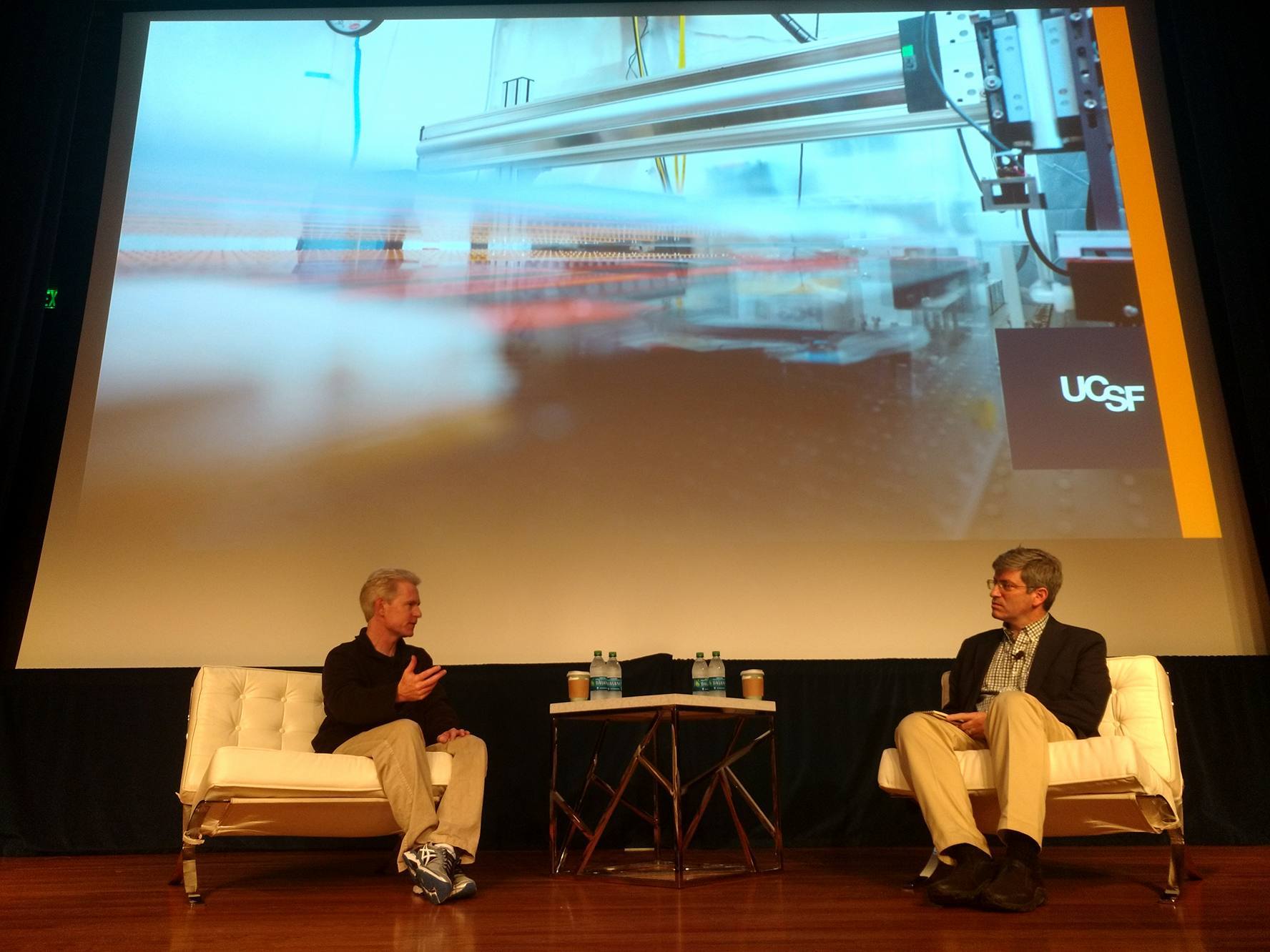Moving from Gut-Based to Data-Based Diagnosis: Joe DeRisi Talks With Carl Zimmer

Biochemist Joe DeRisi (left) of UC San Francisco and New York Times columnist Carl Zimmer discussed the future of medical diagnostics. Photo: Setsen Altan-Ochir
SAN FRANCISCO—You might be 97% human and 3%… tapeworm. At least that’s what researchers at the Chan Zuckerberg Biohub learned when they sequenced one man’s DNA.
Biochemist Joe DeRisi of the University of California, San Francisco, co-president of the Biohub, recounted this parasitic tale during a conversation with New York Times columnist Carl Zimmer on 29 October at the World Conference of Science Journalists 2017. The duo discussed the next-generation sequencing technology used by DeRisi’s team—and the potential for scaling up the research to diagnose diseases around the world.
“If the doctors are ever calling me, it is a super bad sign. You don't want your doc calling me."
Julian (not his real name), a construction worker, had chronic headaches and double vision. MRIs and extensive tests offered few clues. With no clear cause, doctors suspected tuberculosis—but only because he had immigrated to the United States from Nicaragua eight years before.
Julian tested negative for TB, but he was put on a TB medication for a year. As his condition worsened, his medical team questioned whether he was taking the drugs as prescribed, so he had to go to the hospital every day after work and take the medicine in front of a nurse. He briefly felt better—probably the effect of the small dose of steroids contained in the TB medicine, which kept his doctors on the wrong path. Finally, an MRI revealed his whole brain stem was inflamed.
That’s when DeRisi, a kind of modern medical detective, was called in. “If the doctors are ever calling me, it is a super bad sign. You don’t want your doc calling me,” he said.
Only 97% human
Every infectious agent (except the malformed proteins called prions) has RNA and DNA, as do all of our human cells. With recent advances in technology, researchers can quickly determine the sequences of these genetic molecules from a sample of blood, stool, or cerebrospinal fluid.
Derisi’s lab team sampled Julian’s cerebrospinal fluid and “sequenced everything in there: DNA in the cells, DNA floating outside the cells,” DeRisi explained. Unlike the gut or the respiratory tract, cerebrospinal fluid doesn’t make contact with the outside world. It should be pristine—99.9% human genome, with nothing alien.
However, Julian’s was only 97% human. The team compared the foreign DNA “to the universe of known sequences, everything that’s ever been put in databases,” Derisi said. Julian’s 3% matched the DNA of Taenia solium, the pork tapeworm. Contracted from eating raw pork, it causes cysticercosis—where the larvae form cysts inside human muscles, the brain, or the eyes.

Taenia solium, the kind of tapeworm found in Julian’s cerebrospinal fluid. Photo: Parasite of the Day
“People have known about [tapeworms] for centuries,” said Zimmer. “How did this get misdiagnosed? Why do we need HAL2001-type computers to get this classic diagnosis? This is absurd!”
(Zimmer happens to have a species of tapeworm named after him [Acanthobothrium zimmeri] for his contributions to public awareness of parasites.)
Sometimes, tapeworms stay small without making cysts. Julian had no discernible cysts, even though he had thousands of sequences of tapeworm in his spine. With the correct diagnosis, treatment was simple: Bendizol, a medicine that kills the worms by preventing them from absorbing sugar.
Julian’s is among many cases where conventional diagnosis fails—costing time, resources, and too many lives. “The bias was built in: I don’t see cysts, therefore that can’t be tapeworm,” DeRisi said.
Cheap and fast sequencing
Conventional diagnosis is subject to physician biases and past experiences. Metagenomic deep sequencing, on the other hand, allows diagnosis of all pathogens in a single test in 24 hours. The usual biases are removed. Soon, DeRisi forecast, it will only take six hours to run the test.
Previously unknown biothreats can be detected in humans as well as in other species. This is timely, given the growing threat of infectious diseases transmitted from animals to humans, such as the Ebola and Zika viruses.
Sequencing is becoming cheap and fast. Any doctor in the U.S. can order the test for neurological infectious disease. “It is up to us, clinical scientists, basic scientists, to actually put [sequencing] into practice and use it,” said DeRisi.
The Chan Zuckerberg Biohub is an independent non-profit affiliated with UC Berkeley, Stanford University, and UCSF. In low-income and developing countries, sequencers are becoming more common, but computing power isn’t keeping up with the data. Biohub researchers, said DeRisi, are “working to provide that computation for free and scale it to the larger global community”—making incorrect gut-based diagnoses a thing of the past.
—
Setsen Altan-Ochir promotes scientific literacy in Mongolia through translating and screening documentaries (artfilm.mn), training students in critical thinking and writing (writers.mn), writing for the Science and Technology Fund, and working for the NGO People in Need. She studied Earth science and is eager to cover science stories from Asia for international outlets. Contact her at setseneee@gmail.com and follow her on Twitter @setsenee.
